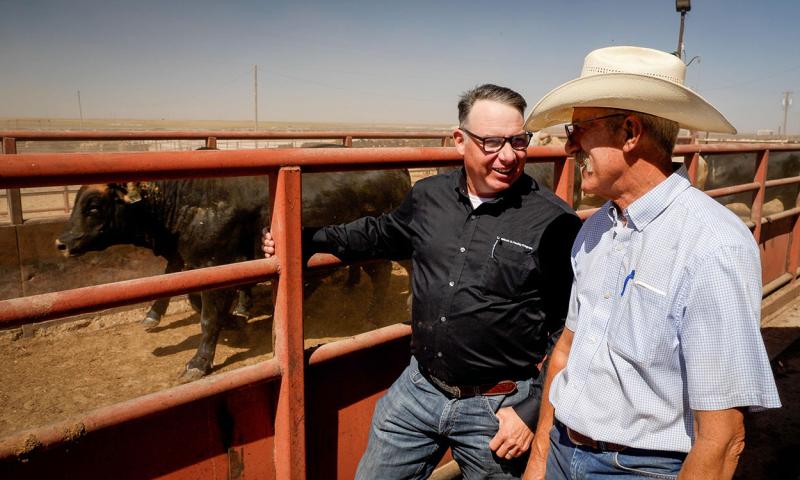Key Points
- Heat stress risk increases after several days of high temperatures and high humidity with little air movement, especially when there is little nighttime cooling.
- Management and animal husbandry practices during a heat event help reduce losses and maintain performance.
- Proactive management plans are more effective than attempting to manage through a crisis event.
Heat stress represents a significant cattle feeding risk. One might expect that cattle at the greatest risk are those fed in desert areas with very high daily temperatures, such as the desert Southwest. In reality, feedlot cattle fed in somewhat cooler, but humid areas, like the Cornbelt, experience heat stress conditions just as severe as regions with higher air temperatures. Feedlot cattle are particularly at risk during seasonal changes when winter and spring conditions give way to summer. Many producers have elected to use shade structures to help cattle adapt to their environment. That is not the only viable approach, however. Managers have other tools at their disposal to mitigate risk.
Heat Stress Risk Factors

Environmental Conditions
It helps to understand how and when heat stress is more likely to occur to plan mitigation steps. Combinations of two or more of the following conditions increase the likelihood of performance losses or mortality from heat stress. These factors include:
- High minimum and maximum daily air temperatures.
- Recent rain events.
- High and persistent humidity.
- Lack of wind for several days (or in pens with extensive wind protection).
- Lack of cloud cover, resulting in more-intense solar radiation.
- Lack of opportunity for cattle to adapt to changing conditions (incomplete hair shedding, rapid change in seasonal conditions).
It helps to think of heat stress as accumulated heat load, somewhat like the “straw that broke the camel’s back.” Cattle can tolerate high daily temperatures if there is an opportunity to cool down at night. Under those conditions, an outside yard might actually be less stressful than a building, as those structures can hold heat longer, especially if there is little breeze.
Cattle and Management Factors
Researchers in Australia developed a heat load index to guide management decisions and assess risk (Sullivan and Mader). Part of that system uses adjustment factors based on cattle characteristics and management practices. Some of those adjustments are listed below in Table 1. Positive values are associated with factors that increase cattles’ heat tolerance, while negative values indicate increased risk of loss from heat stress.
| Factor |
|
|---|---|
| Days on feed (0 to 80) |
|
| Days on feed (> 130) |
|
| Black coat |
|
| Red coat |
|
| White coat |
|
| Sick or unacclimated |
|
| No shade |
|
| Shade (16 – 22 square feet per head) |
|
| Shade (22-32 square feet per head) |
|
| Providing extra water tanks |
|
| Cleaning high manure areas |
|
Adapted from Sullivan and Mader, 2018. Managing Heat Stress Episodes in Confined Cattle. Vet Clin. North Am Food Anim. Pract.
Cattle vary in their susceptibility to heat stress. An obvious example is Bos indicus influenced genetics; while a rarity in the Northern Plains, they are well-adapted to hot weather. Dark-colored cattle that have been on feed for an extended period of time are more susceptible than lighter-colored cattle that are lighter weight.
Minimizing Heat Stress Impacts

Animal Husbandry
Animal husbandry practices influence how well cattle handle heat stress events. Shade structures, as discussed earlier, allow cattle the opportunity to minimize heat load increases from solar radiation. Most feeders think of bedding as a winter management practice, but bedding areas of the pen provide insulation to reduce heat gain from the ground. Removing manure to prevent excess accumulation reduces the potential for muddy pens following precipitation events that could make heat stress conditions worse.
Water Intake
Providing sufficient water intake is critically important to minimize performance losses and health risks during heat events. Cattle require two to three times as much water when temperatures increase from 68 to 95 degrees Fahrenheit. Placing additional water tanks in the pen helps ensure that water intake is not limited, whether caused by lack of watering space or inadequate flow rates.
Watering Pen Surfaces
Watering pen surfaces provides a heat sink for cattle to get rid of excess body heat, helping them adapt to hot conditions. Those benefits are enhanced if done at night or in the morning. Watering at night speeds up cattles’ return to normal conditions, while early morning applications delay heat load accumulation. Intermittent sprinkling reduces water use and the potential for mud build up. Before implementing a sprinkling program, make certain there is a sufficient flow rate to handle both sprinkling and water intake demands.


